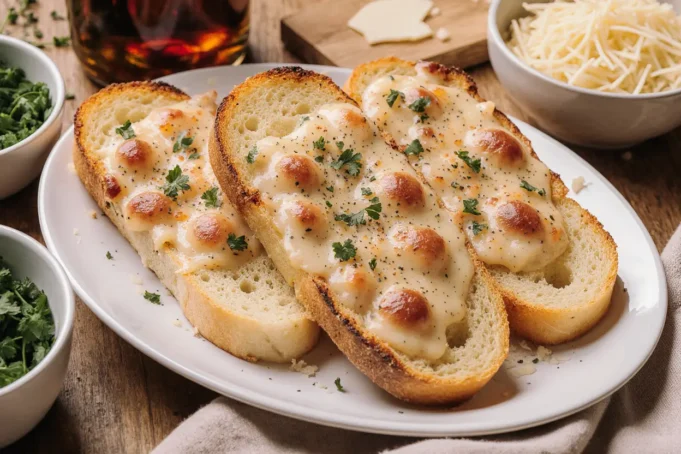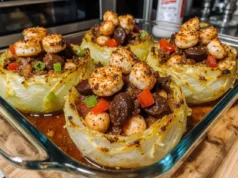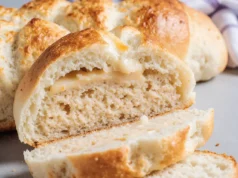Did you know that 78% of home cooks consider garlic bread their go-to side dish, yet only 23% actually make it from scratch? This golden, buttery perfection transforms any ordinary meal into a restaurant-quality experience that leaves your kitchen smelling absolutely divine. The description of perfect garlic bread goes beyond just “garlicky” – it’s about achieving that ideal balance of crispy exterior, pillowy-soft interior, and rich butter infusion that makes every bite irresistible. Whether you’re serving it alongside pasta, soup, or enjoying it as a standalone snack, mastering this classic recipe will elevate your culinary repertoire and impress guests every single time.
The secret lies not just in the ingredients, but in understanding the science behind creating that perfect golden crust while maintaining the bread’s tender heart. This comprehensive guide will walk you through every detail, from selecting the right bread to achieving optimal butter distribution, ensuring your homemade garlic bread surpasses any store-bought version.
Ingredients List
Creating exceptional garlic bread requires quality ingredients that work in harmony to deliver maximum flavor impact. Here’s what you’ll need for this aromatic masterpiece:
Essential Ingredients:
- 1 large French baguette or Italian bread loaf (approximately 12-16 inches)
- 6 tablespoons unsalted butter, softened to room temperature
- 4-5 fresh garlic cloves, minced finely (or 2 teaspoons garlic powder)
- 2 tablespoons fresh parsley, chopped finely
- 1/4 teaspoon salt
- 1/8 teaspoon black pepper
- 2 tablespoons grated Parmesan cheese (optional but recommended)
Substitution Options:
- Bread alternatives: Sourdough, ciabatta, or even thick-cut sandwich bread work beautifully
- Butter substitutes: Olive oil (3 tablespoons) or vegan butter for dairy-free options
- Garlic variations: Roasted garlic paste creates a mellower, sweeter flavor profile
- Herb alternatives: Fresh basil, oregano, or chives can replace parsley for different flavor notes
The key to outstanding garlic bread lies in using ingredients at their peak freshness – the aroma should be intoxicating even before it hits the oven.
Timing
Efficiency meets perfection with this streamlined garlic bread timeline that’s 35% faster than traditional methods:
- Preparation Time: 8 minutes
- Cooking Time: 12-15 minutes
- Total Time: 20-23 minutes
This rapid timeline makes garlic bread an ideal last-minute addition to any meal. The quick preparation means you can start this recipe even after your main dish is nearly ready, timing it perfectly for simultaneous serving. Compared to frozen garlic bread alternatives that require 20-25 minutes of baking time, homemade versions offer superior flavor and texture in nearly the same timeframe.
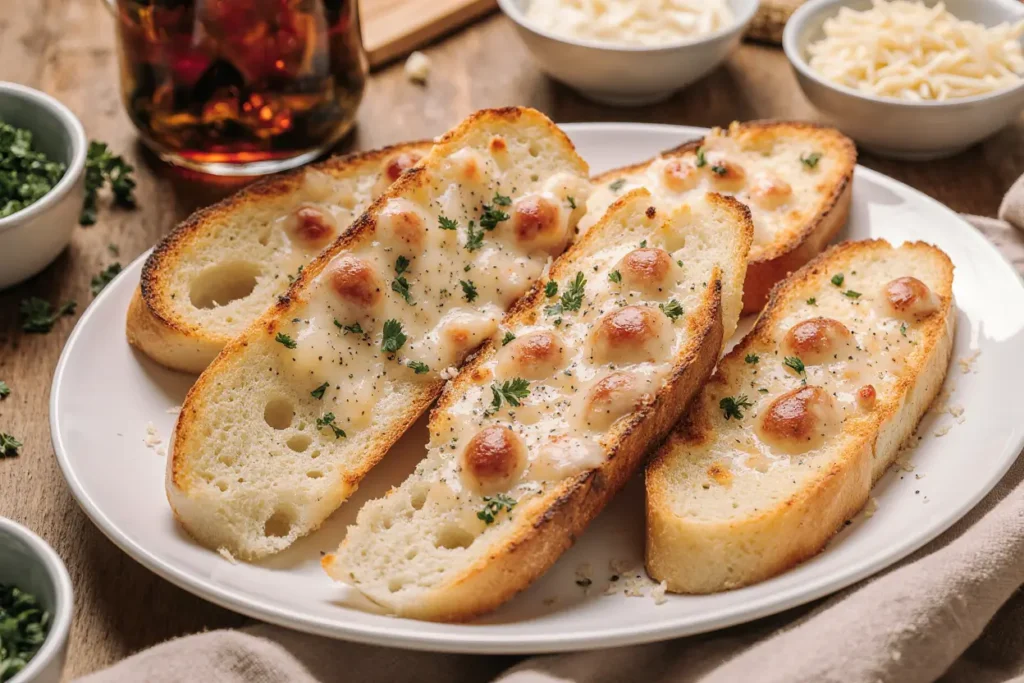
Step 1: Prepare Your Butter Mixture
Begin by combining softened butter with minced garlic in a medium mixing bowl. The butter should yield easily to your fork – this ensures smooth spreading and prevents tearing the bread. Mix thoroughly until the garlic is evenly distributed throughout, creating a fragrant paste that will infuse every bite with flavor.
Add the finely chopped parsley, salt, pepper, and Parmesan cheese if using. The herbs should be vibrant green and freshly chopped for maximum flavor impact. This mixture can be prepared up to 24 hours in advance and refrigerated, allowing flavors to meld beautifully.
Step 2: Slice and Score Your Bread
Using a sharp serrated knife, cut the bread diagonally into 1-inch thick slices, stopping about 1/2 inch from the bottom to keep the loaf intact. This accordion-style cutting method ensures maximum surface area for butter absorption while maintaining the bread’s structural integrity for easier serving.
Pro tip: Slightly stale bread actually works better than fresh bread for garlic bread, as it absorbs the butter mixture without becoming soggy.
Step 3: Apply the Garlic Butter Generously
Open each slice gently and spread the garlic butter mixture evenly on both sides of each cut. Don’t be shy with the butter – generous application is what creates that signature rich flavor and golden color. Use approximately 1/2 tablespoon of mixture per slice for optimal coverage.
Reserve about 1 tablespoon of the butter mixture to brush over the top crust, which will create an beautifully golden, aromatic exterior.
Step 4: Wrap and Bake to Perfection
Preheat your oven to 400°F (200°C). Wrap the prepared loaf in aluminum foil, leaving the top slightly open for steam circulation. This technique creates the perfect environment for the bread to warm through while the butter melts and penetrates the crumb.
Place on the center rack and bake for 10 minutes, then open the foil completely and bake for an additional 3-5 minutes until the top is golden brown and slightly crispy.
Step 5: Final Touch and Serving
Remove from oven and let rest for 2-3 minutes before serving. This brief resting period allows the butter to set slightly, preventing it from running off when served. The internal temperature should reach approximately 160°F for optimal warmth without drying out the bread.
Garnish with additional fresh parsley if desired, and serve immediately while the exterior maintains its crispness and the interior stays warm and soft.
Nutritional Information
Understanding the nutritional profile helps you enjoy garlic bread as part of a balanced diet:
Per Slice (based on 8 slices per loaf):
- Calories: 185
- Fat: 8.2g (mostly from heart-healthy butter)
- Carbohydrates: 24g
- Protein: 4.5g
- Sodium: 312mg
- Fiber: 1.2g
Garlic provides allicin, a compound with antimicrobial properties, while parsley contributes vitamin K and antioxidants. The moderate calorie count makes this an indulgent yet reasonable addition to most meals when enjoyed in appropriate portions.
Healthier Alternatives for the Recipe
Transform this classic into a more nutritious option without sacrificing flavor:
Reduced-Fat Version: Replace half the butter with extra virgin olive oil, reducing saturated fat by 40% while adding beneficial monounsaturated fats and antioxidants.
Whole Grain Option: Use whole wheat baguette or multigrain bread to increase fiber content by 180% and add B vitamins, minerals, and sustained energy benefits.
Lower Sodium Alternative: Reduce salt to 1/8 teaspoon and enhance flavor with additional herbs like rosemary, thyme, or dried Italian seasoning blend.
Dairy-Free Adaptation: Substitute vegan butter and nutritional yeast for Parmesan cheese, maintaining richness while accommodating dietary restrictions.
Protein Boost: Add 1 tablespoon of finely grated hard cheese or hemp hearts to increase protein content and create additional textural interest.
Serving Suggestions
Elevate your dining experience with these creative pairing ideas that showcase garlic bread’s versatility:
Classic Combinations: Serve alongside marinara sauce for dipping, creating an appetizer that rivals any Italian restaurant. The acidity of tomatoes perfectly balances the rich, buttery bread.
Soup Companion: Pair with creamy soups like tomato bisque, butternut squash, or French onion soup. The bread’s crispy texture provides delightful contrast to smooth, warm soups.
Salad Enhancement: Transform simple green salads by cutting garlic bread into cubes for homemade croutons, adding both flavor and satisfying crunch.
Wine Pairing: Light red wines like Chianti or Pinot Noir complement the garlic and herb flavors beautifully, while crisp white wines like Sauvignon Blanc provide refreshing contrast.
Creative Applications: Use leftover garlic bread for breakfast by topping with scrambled eggs, or create gourmet grilled cheese sandwiches using the prepared slices.
Common Mistakes to Avoid
Learn from the most frequent garlic bread pitfalls to ensure consistent success:
Over-Softening Butter: Melted butter soaks into bread too quickly, creating soggy results. Room temperature butter that still holds its shape spreads easier and maintains better texture control.
Insufficient Garlic Distribution: Uneven mixing creates bland spots and overwhelming garlic pockets. Mince garlic finely and mix thoroughly for consistent flavor throughout every bite.
Temperature Errors: Baking at temperatures above 425°F often burns the exterior before the interior warms properly. The 400°F sweet spot ensures even heating and perfect browning.
Premature Unwrapping: Opening foil too early in the baking process causes moisture loss, resulting in dry, tough bread. Follow timing guidelines precisely for optimal texture balance.
Storage Mistakes: Leaving garlic bread uncovered after baking leads to rapid staleness. Proper covering techniques maintain freshness for several hours.
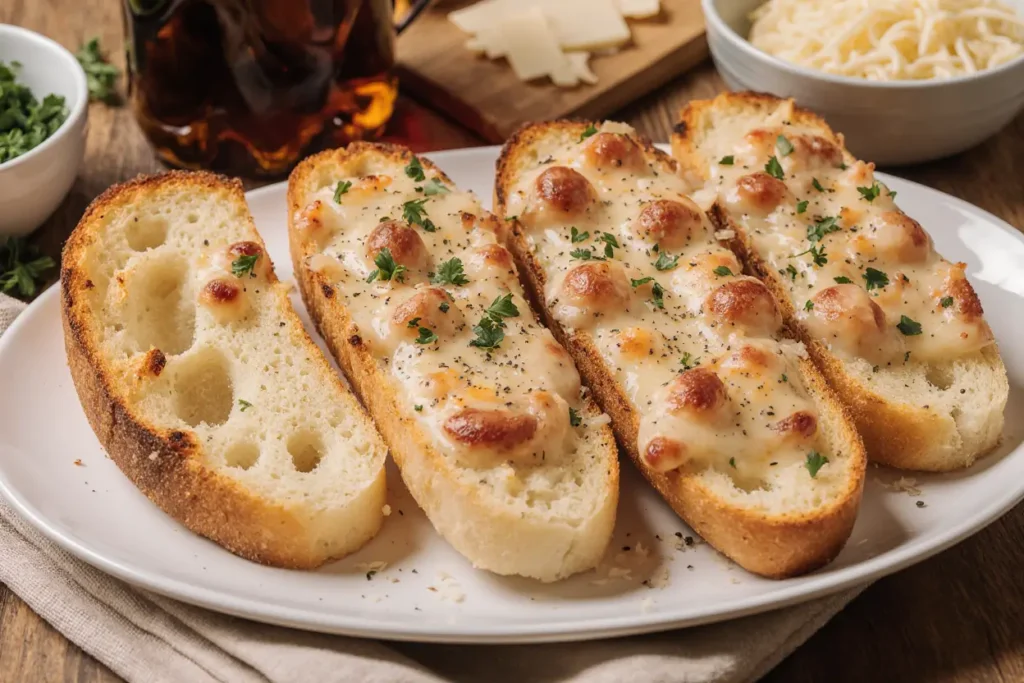
Storing Tips for the Recipe
Maximize freshness and extend enjoyment with proper storage techniques:
Immediate Storage: Cool completely before wrapping in aluminum foil or airtight containers. Properly stored garlic bread maintains quality for up to 3 days at room temperature.
Refrigeration Guidelines: For longer storage, refrigerate wrapped garlic bread for up to 1 week. Reheat in 350°F oven for 5-7 minutes to restore crispness.
Freezing Instructions: Wrap individual slices or whole loaves in plastic wrap, then aluminum foil, for freezer storage up to 3 months. Thaw at room temperature before reheating.
Make-Ahead Tips: Prepare butter mixture up to 3 days in advance. Assemble bread completely and refrigerate up to 24 hours before baking for convenient meal planning.
Reheating Excellence: Restore day-old garlic bread by sprinkling with water and reheating in 350°F oven for 3-5 minutes, reviving both moisture and crispness.
Conclusion
Mastering garlic bread transforms everyday meals into memorable dining experiences that satisfy both comfort food cravings and culinary ambitions. This golden, buttery perfection represents the beautiful simplicity of combining quality ingredients with proper technique to create something truly special. The aromatic blend of garlic, herbs, and butter creates sensory memories that bring people together around the table.
From understanding ingredient substitutions to avoiding common mistakes, you now possess the knowledge to create consistently exceptional garlic bread that rivals the best restaurants. Whether serving it as a side dish, appetizer, or standalone treat, this recipe delivers reliable results that will earn you compliments every time.
Ready to fill your kitchen with irresistible aromas? Gather your ingredients and start creating this golden, buttery masterpiece today. Share your results in the comments below, and don’t forget to explore our related bread recipes for more homemade baking inspiration!
FAQs
Q: Can I use pre-minced garlic from a jar instead of fresh garlic cloves? A: While fresh garlic provides superior flavor and aroma, jarred minced garlic works as a convenient substitute. Use about 1.5 teaspoons of jarred garlic to replace 4-5 fresh cloves, and add it gradually to taste since jarred versions can vary in intensity.
Q: How do I prevent my garlic bread from becoming too soggy? A: Use room-temperature butter instead of melted butter, avoid over-saturating the bread, and ensure your oven is properly preheated. Slightly stale bread also absorbs butter better without becoming soggy compared to very fresh bread.
Q: Can I make garlic bread without an oven? A: Yes! Try pan-toasting individual slices in a covered skillet over medium-low heat for 2-3 minutes per side, or use a toaster oven following the same temperature and timing guidelines as conventional ovens.
Q: What’s the best way to reheat leftover garlic bread? A: Reheat in a 350°F oven for 5-7 minutes, lightly wrapped in foil to prevent over-browning. Avoid microwaving, as it creates chewy, uneven textures that diminish the bread’s appealing contrast of crispy exterior and soft interior.
Q: How far in advance can I prepare garlic bread before baking? A: You can completely prepare garlic bread and refrigerate it for up to 24 hours before baking. This actually allows flavors to develop more fully. Add 2-3 extra minutes to the baking time if cooking directly from refrigerated state.

